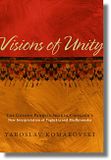Visions of Unity
Komarovski, Yaroslav:
Visions of Unity : the Golden Paṇḍita Shakya Chokden's new interpretation of Yogācāra and Madhyamaka / Yaroslav Komarovski. - Albany : State University of New York Press, 2011. - xii, 451 S.
Hochschulschrift. Teilw. zugl.: Charlottesville, Univ. of Virginia, Diss., 2007 unter dem Titel: Echoes of empty luminosity : reevaluation and unique interpretation of Yogācāra and Niḥsvabhāvavāda Madhyamaka by the fifteenth century Tibetan thinker Śākya mchog ldan
ISBN 978-1-4384-3909-9
US$ 90,00 (Hardcover)
ISBN 978-1-4384-3910-5
US$ 29,95 (Paperback)
ISBN 978-1-4384-3911-2
US$ 90,00 (eBook)
DDC: 294.392
Beschreibung
This landmark book discusses the thought of Tibetan Buddhist thinker Shakya Chokden [Śākya-mchog-ldan gSer-mdog paṇ-chen] (1428–1507) on the two major systems of Mahayana Buddhism. Influential and controversial in his own day, Shakya Chokden’s thought fell out of favor over time and his writings were eventually repressed, becoming available again only in the 1970s. Yet, his startling interpretations of the core areas of Buddhist thought remain valuable and well worth consideration today. Yaroslav Komarovski has used the twenty-four volumes of Shakya Chokden’s collected work to provide a systematic presentation of a central aspect of his thought: a reconciliation of Yogacara and Madhyamaka. Providing a detailed analysis of the two systems’ mutual refutations of each other, Shakya Chokden argues for their fundamental compatibility and shared vision.
In analyzing Shakya Chokden’s ideas, Komarovski explores some of the most important issues of both traditional and modern Buddhist scholarship, including contested approaches to the nature of reality, the relationship between philosophy and contemplative practice, inter- and intrasectarian Buddhist polemics, and the nature of consciousness and mental processes. [Verlagsinformation]
Inhalt
List of Tables. ix
Acknowledgments. xi
Introduction. 1
1. Introducing the Visions of Unity. 6
2. Introducting the Chapters. 11
I. LIFE AND WORKS OF THE GOLDEN PAṆḌITA. 17
1. Political and Religious Landscape of Fifteenth-Century Tibet. 17
2. Life of the Golden Paṇḍita. 23
3. Writings of a Shakya Chokden. 51
II. THE INTELLECTUAL BACKGROUND OF SHAKYA CHOKDEN’S INTERPRETATION OF YOGĀCĀRA AND MADHYAMAKA. 71
1. Two Tendencies in Yogācāra and Niḥsvabhāvavāda Writings. 71
2. Basic Elements of Shakya Chokden’s Approach to Mahāyāna Systems. 84
3. Pointed Disappointments: Shakya Chokden’s Personal Reflections. 91
4. Broadening Empty Horizons: A Note on Changes in Shakya Chokden’s Views. 102
III. READJUSTING RUNGS OF THE LADDER: REVISITING DOXOGRAPHICAL HIERARCHIES. 109
1. Key Features of Shakya Chokden’s Approach to the Buddhist Tenets. 109
2. Demarcating the Middle: On the Valid Divisions of Madhyamaka and Great Madhyamaka. 116
3. Self-Emptiness and Other-Emptiness. 122
4. Bidding Farewell to the Prāsagika/Svātantrika Division? 136
5. Are There Two Types of Yogācāra Madhyamaka? 141
6. Are There Any Cittamātra Followers Around? 145
7. Expanding they Mādhyamika Camp. 150
IV. THROUGH BROKEN BOUNDARIES TO NEW ENCLOSURES: RECONCILING YOGĀCĀRA AND MADHYAMAKA. 157
1. Differences between Alīkākāravāda and Satyākāravāda. 157
2. The Heart of the Matter: Probing the Alīkākāravāda/Niḥsvabhāvavāda Distinction. 168
3. A New Look at the Old Origins: Distinctions of Madhyamaka Stemming from Interpretations of the Second and Third Dharmacakras. 183
4. Steering the Middle Way between the Two Conflicting Middle Ways: The Art of Not Taking Sides. 207
V. EXPLORATIONS IN EMPTY LUMINOSITY: SHAKYA CHOKDEN’S POSITION ON PRIMORDIAL MIND. 213
1. Facing the Reality of Primordial Mind. 213
2. Primordial Mind as an Impermanent Phenomenon. 228
3. (Un)linking the Self-Cognizing Primordial Mind and Dualistic Consciousness. 238
4. Does Self-Cognition Cognize Itself? 242
5. Primordial Mind as the Bridge between Yogācāra and Tantra. 249
Conclusion: The Grand Unity - Shakya Chokden’s Middle Way. 269
Glossary of Buddhist Terms: English-Tibetan with Sanskrit Parallels. 279
Spellings of Tibetan Names and Terms. 299
Notes. 307
Bibliography. 391
Index. 423
Autor
YAROSLAV KOMAROVSKI is Assistant Professor of Religious Studies at the University of Nebraska–Lincoln. Profile page.
Quellen: SUNY Press; WorldCat; Amazon
Ähnlich
- Mining for Wisdom within Delusion
- Tāranātha no dBu ma theg mchog kenkyū
- Rakow: Transformationen des tibetischen Buddhismus
- Tiso: Liberation in One Lifetime
- Dalai Lama V.: The Illusive Play
- Schmithausen: The Genesis of Yogācāra-Vijñānavāda
- Sihlé: Rituels bouddhistes de pouvoir et de violence
- Zivkovic: Death and Reincarnation in Tibetan Buddhism
- Monastic and Lay Traditions in North-Eastern Tibet
- Schneider: Le renoncement au féminin

